CSU Project: Literature Review on IoT Applications in Smart Cities
VerifiedAdded on 2023/06/07
|11
|3133
|145
Literature Review
AI Summary
This document presents a literature review focusing on the role of the Internet of Things (IoT) in smart cities. It begins by addressing the definition and vision of smart cities, highlighting the market's potential and challenges related to political, technical, and financial factors. The review then delves into specific IoT applications, including smart health monitoring of buildings, waste management optimization, traffic congestion reduction, noise monitoring, and smart parking solutions. Each application is discussed with relevant research and examples, showcasing the benefits and potential implications of IoT in urban environments. The document concludes with an annotated bibliography of key papers, summarizing their contributions to the field and their relevance to understanding the physical environment of smart cities. Desklib provides access to this document, offering students a valuable resource for research and academic exploration in the field of smart city technologies.
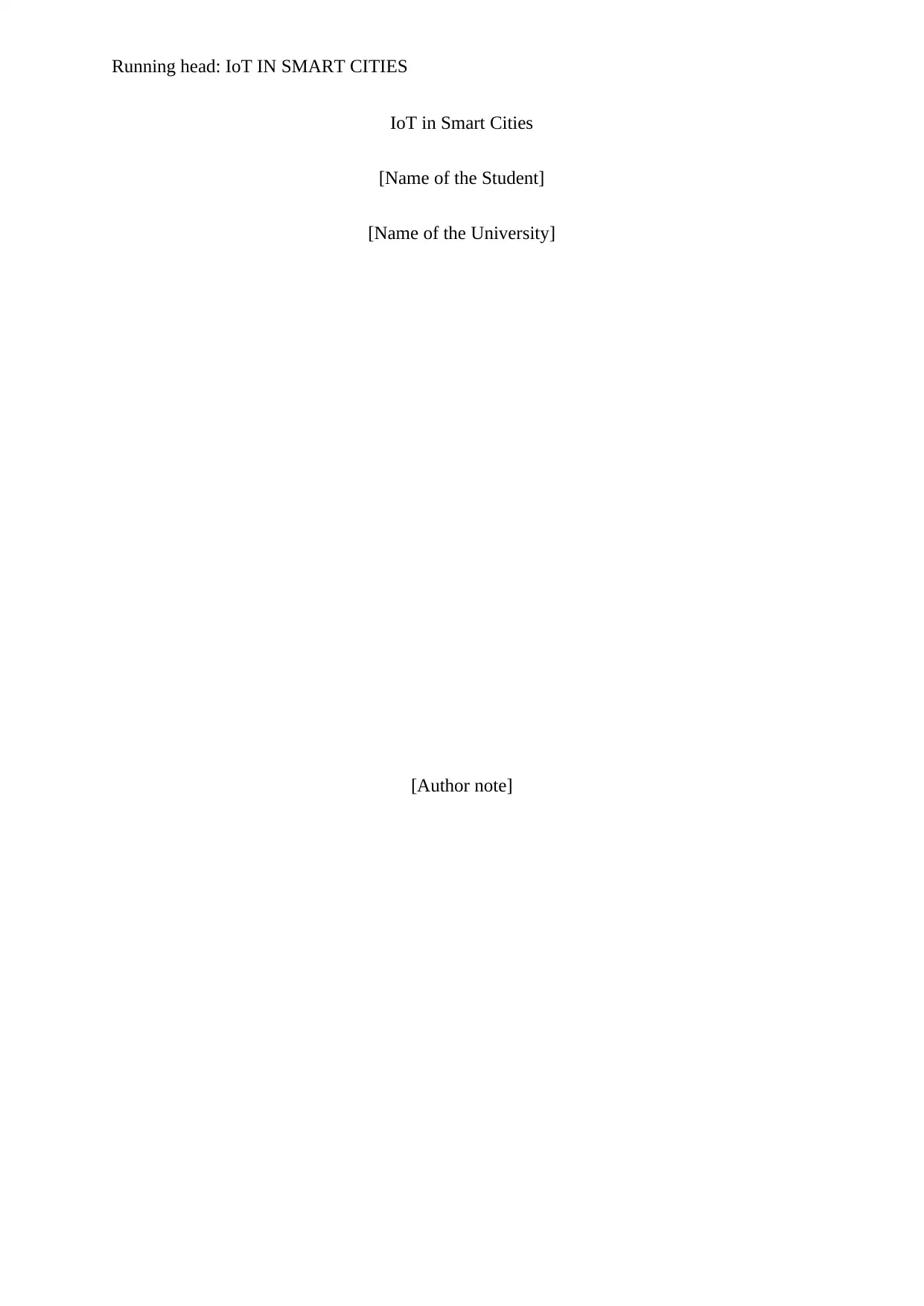
Running head: IoT IN SMART CITIES
IoT in Smart Cities
[Name of the Student]
[Name of the University]
[Author note]
IoT in Smart Cities
[Name of the Student]
[Name of the University]
[Author note]
Paraphrase This Document
Need a fresh take? Get an instant paraphrase of this document with our AI Paraphraser
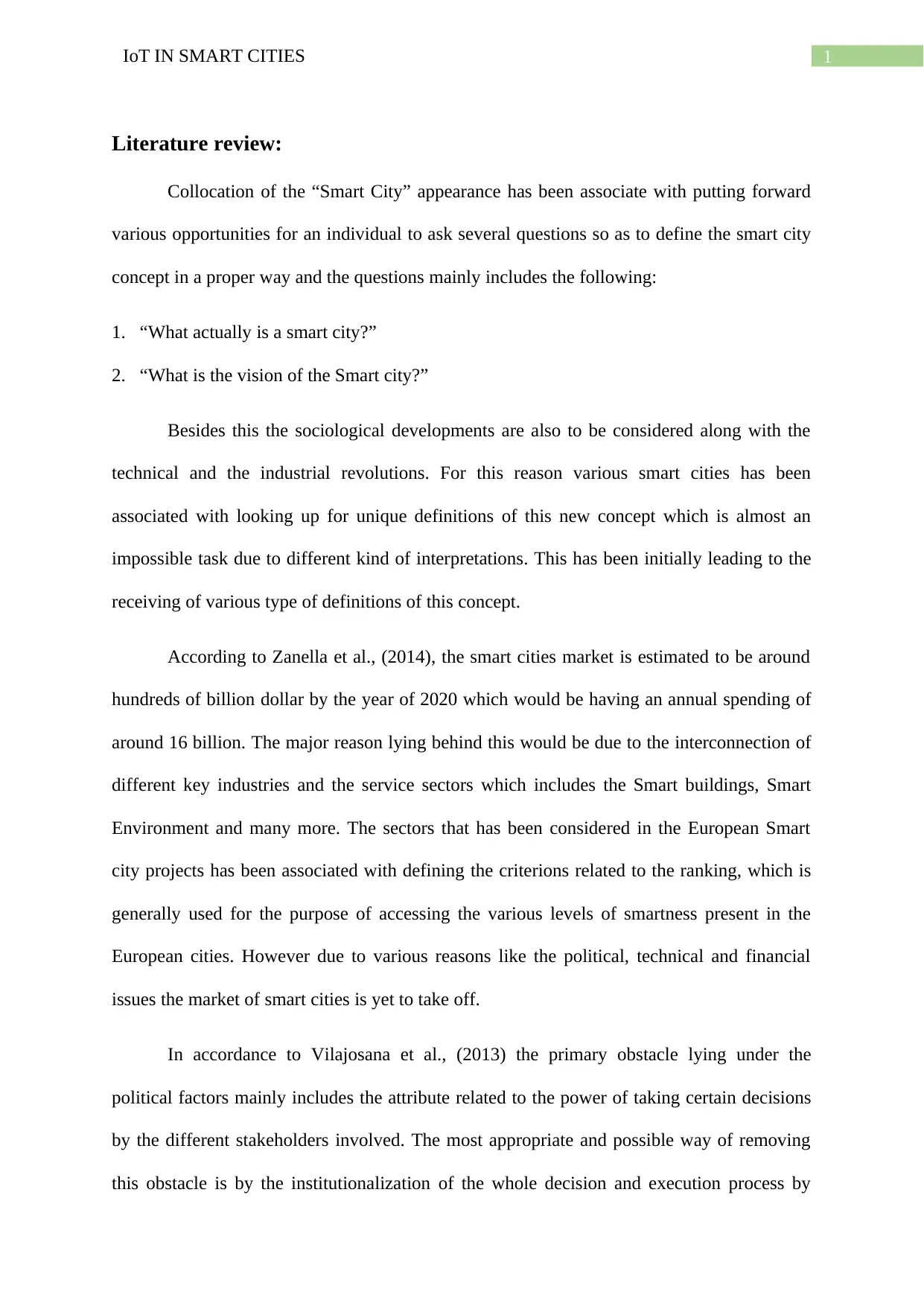
1IoT IN SMART CITIES
Literature review:
Collocation of the “Smart City” appearance has been associate with putting forward
various opportunities for an individual to ask several questions so as to define the smart city
concept in a proper way and the questions mainly includes the following:
1. “What actually is a smart city?”
2. “What is the vision of the Smart city?”
Besides this the sociological developments are also to be considered along with the
technical and the industrial revolutions. For this reason various smart cities has been
associated with looking up for unique definitions of this new concept which is almost an
impossible task due to different kind of interpretations. This has been initially leading to the
receiving of various type of definitions of this concept.
According to Zanella et al., (2014), the smart cities market is estimated to be around
hundreds of billion dollar by the year of 2020 which would be having an annual spending of
around 16 billion. The major reason lying behind this would be due to the interconnection of
different key industries and the service sectors which includes the Smart buildings, Smart
Environment and many more. The sectors that has been considered in the European Smart
city projects has been associated with defining the criterions related to the ranking, which is
generally used for the purpose of accessing the various levels of smartness present in the
European cities. However due to various reasons like the political, technical and financial
issues the market of smart cities is yet to take off.
In accordance to Vilajosana et al., (2013) the primary obstacle lying under the
political factors mainly includes the attribute related to the power of taking certain decisions
by the different stakeholders involved. The most appropriate and possible way of removing
this obstacle is by the institutionalization of the whole decision and execution process by
Literature review:
Collocation of the “Smart City” appearance has been associate with putting forward
various opportunities for an individual to ask several questions so as to define the smart city
concept in a proper way and the questions mainly includes the following:
1. “What actually is a smart city?”
2. “What is the vision of the Smart city?”
Besides this the sociological developments are also to be considered along with the
technical and the industrial revolutions. For this reason various smart cities has been
associated with looking up for unique definitions of this new concept which is almost an
impossible task due to different kind of interpretations. This has been initially leading to the
receiving of various type of definitions of this concept.
According to Zanella et al., (2014), the smart cities market is estimated to be around
hundreds of billion dollar by the year of 2020 which would be having an annual spending of
around 16 billion. The major reason lying behind this would be due to the interconnection of
different key industries and the service sectors which includes the Smart buildings, Smart
Environment and many more. The sectors that has been considered in the European Smart
city projects has been associated with defining the criterions related to the ranking, which is
generally used for the purpose of accessing the various levels of smartness present in the
European cities. However due to various reasons like the political, technical and financial
issues the market of smart cities is yet to take off.
In accordance to Vilajosana et al., (2013) the primary obstacle lying under the
political factors mainly includes the attribute related to the power of taking certain decisions
by the different stakeholders involved. The most appropriate and possible way of removing
this obstacle is by the institutionalization of the whole decision and execution process by
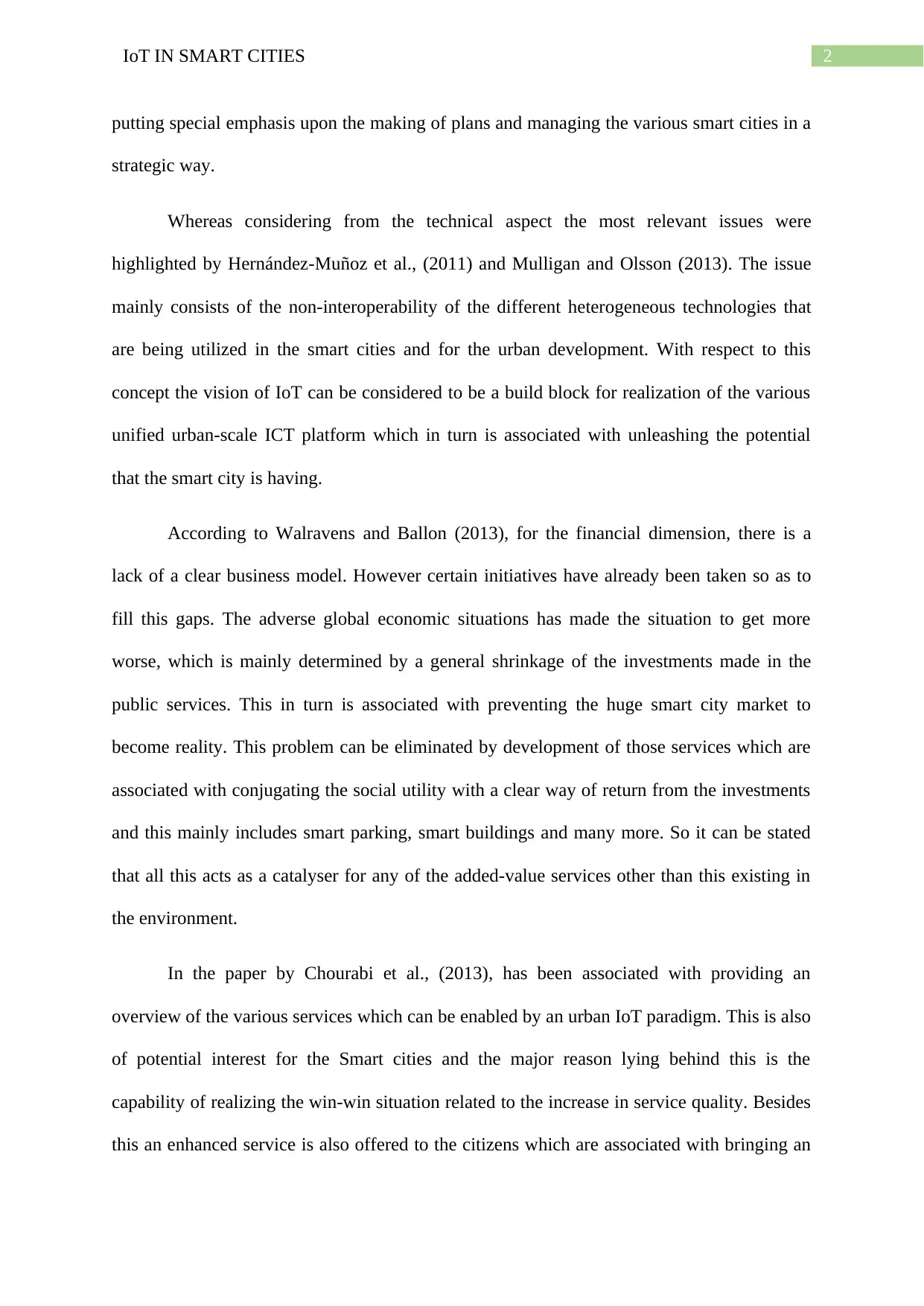
2IoT IN SMART CITIES
putting special emphasis upon the making of plans and managing the various smart cities in a
strategic way.
Whereas considering from the technical aspect the most relevant issues were
highlighted by Hernández-Muñoz et al., (2011) and Mulligan and Olsson (2013). The issue
mainly consists of the non-interoperability of the different heterogeneous technologies that
are being utilized in the smart cities and for the urban development. With respect to this
concept the vision of IoT can be considered to be a build block for realization of the various
unified urban-scale ICT platform which in turn is associated with unleashing the potential
that the smart city is having.
According to Walravens and Ballon (2013), for the financial dimension, there is a
lack of a clear business model. However certain initiatives have already been taken so as to
fill this gaps. The adverse global economic situations has made the situation to get more
worse, which is mainly determined by a general shrinkage of the investments made in the
public services. This in turn is associated with preventing the huge smart city market to
become reality. This problem can be eliminated by development of those services which are
associated with conjugating the social utility with a clear way of return from the investments
and this mainly includes smart parking, smart buildings and many more. So it can be stated
that all this acts as a catalyser for any of the added-value services other than this existing in
the environment.
In the paper by Chourabi et al., (2013), has been associated with providing an
overview of the various services which can be enabled by an urban IoT paradigm. This is also
of potential interest for the Smart cities and the major reason lying behind this is the
capability of realizing the win-win situation related to the increase in service quality. Besides
this an enhanced service is also offered to the citizens which are associated with bringing an
putting special emphasis upon the making of plans and managing the various smart cities in a
strategic way.
Whereas considering from the technical aspect the most relevant issues were
highlighted by Hernández-Muñoz et al., (2011) and Mulligan and Olsson (2013). The issue
mainly consists of the non-interoperability of the different heterogeneous technologies that
are being utilized in the smart cities and for the urban development. With respect to this
concept the vision of IoT can be considered to be a build block for realization of the various
unified urban-scale ICT platform which in turn is associated with unleashing the potential
that the smart city is having.
According to Walravens and Ballon (2013), for the financial dimension, there is a
lack of a clear business model. However certain initiatives have already been taken so as to
fill this gaps. The adverse global economic situations has made the situation to get more
worse, which is mainly determined by a general shrinkage of the investments made in the
public services. This in turn is associated with preventing the huge smart city market to
become reality. This problem can be eliminated by development of those services which are
associated with conjugating the social utility with a clear way of return from the investments
and this mainly includes smart parking, smart buildings and many more. So it can be stated
that all this acts as a catalyser for any of the added-value services other than this existing in
the environment.
In the paper by Chourabi et al., (2013), has been associated with providing an
overview of the various services which can be enabled by an urban IoT paradigm. This is also
of potential interest for the Smart cities and the major reason lying behind this is the
capability of realizing the win-win situation related to the increase in service quality. Besides
this an enhanced service is also offered to the citizens which are associated with bringing an
⊘ This is a preview!⊘
Do you want full access?
Subscribe today to unlock all pages.

Trusted by 1+ million students worldwide
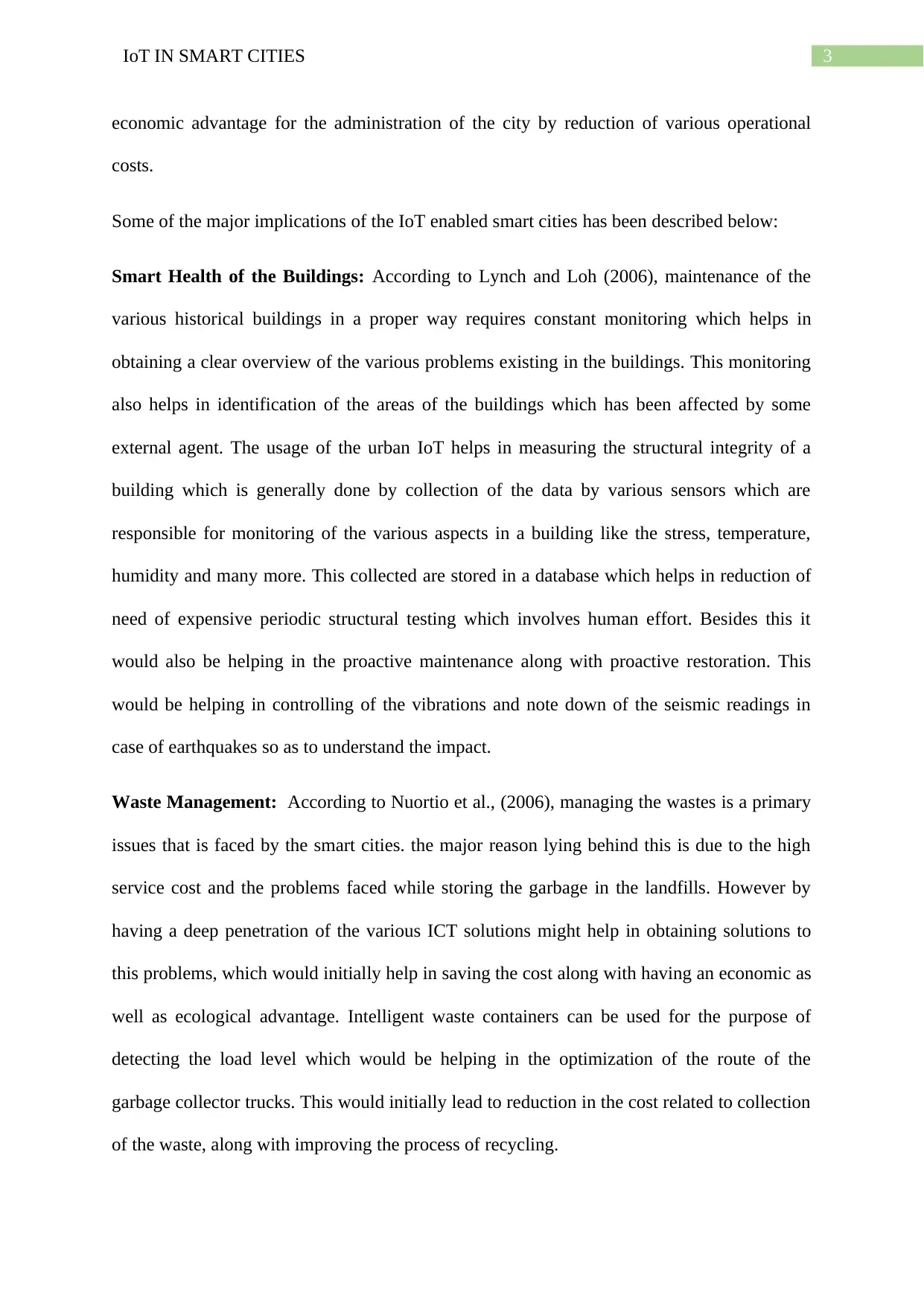
3IoT IN SMART CITIES
economic advantage for the administration of the city by reduction of various operational
costs.
Some of the major implications of the IoT enabled smart cities has been described below:
Smart Health of the Buildings: According to Lynch and Loh (2006), maintenance of the
various historical buildings in a proper way requires constant monitoring which helps in
obtaining a clear overview of the various problems existing in the buildings. This monitoring
also helps in identification of the areas of the buildings which has been affected by some
external agent. The usage of the urban IoT helps in measuring the structural integrity of a
building which is generally done by collection of the data by various sensors which are
responsible for monitoring of the various aspects in a building like the stress, temperature,
humidity and many more. This collected are stored in a database which helps in reduction of
need of expensive periodic structural testing which involves human effort. Besides this it
would also be helping in the proactive maintenance along with proactive restoration. This
would be helping in controlling of the vibrations and note down of the seismic readings in
case of earthquakes so as to understand the impact.
Waste Management: According to Nuortio et al., (2006), managing the wastes is a primary
issues that is faced by the smart cities. the major reason lying behind this is due to the high
service cost and the problems faced while storing the garbage in the landfills. However by
having a deep penetration of the various ICT solutions might help in obtaining solutions to
this problems, which would initially help in saving the cost along with having an economic as
well as ecological advantage. Intelligent waste containers can be used for the purpose of
detecting the load level which would be helping in the optimization of the route of the
garbage collector trucks. This would initially lead to reduction in the cost related to collection
of the waste, along with improving the process of recycling.
economic advantage for the administration of the city by reduction of various operational
costs.
Some of the major implications of the IoT enabled smart cities has been described below:
Smart Health of the Buildings: According to Lynch and Loh (2006), maintenance of the
various historical buildings in a proper way requires constant monitoring which helps in
obtaining a clear overview of the various problems existing in the buildings. This monitoring
also helps in identification of the areas of the buildings which has been affected by some
external agent. The usage of the urban IoT helps in measuring the structural integrity of a
building which is generally done by collection of the data by various sensors which are
responsible for monitoring of the various aspects in a building like the stress, temperature,
humidity and many more. This collected are stored in a database which helps in reduction of
need of expensive periodic structural testing which involves human effort. Besides this it
would also be helping in the proactive maintenance along with proactive restoration. This
would be helping in controlling of the vibrations and note down of the seismic readings in
case of earthquakes so as to understand the impact.
Waste Management: According to Nuortio et al., (2006), managing the wastes is a primary
issues that is faced by the smart cities. the major reason lying behind this is due to the high
service cost and the problems faced while storing the garbage in the landfills. However by
having a deep penetration of the various ICT solutions might help in obtaining solutions to
this problems, which would initially help in saving the cost along with having an economic as
well as ecological advantage. Intelligent waste containers can be used for the purpose of
detecting the load level which would be helping in the optimization of the route of the
garbage collector trucks. This would initially lead to reduction in the cost related to collection
of the waste, along with improving the process of recycling.
Paraphrase This Document
Need a fresh take? Get an instant paraphrase of this document with our AI Paraphraser
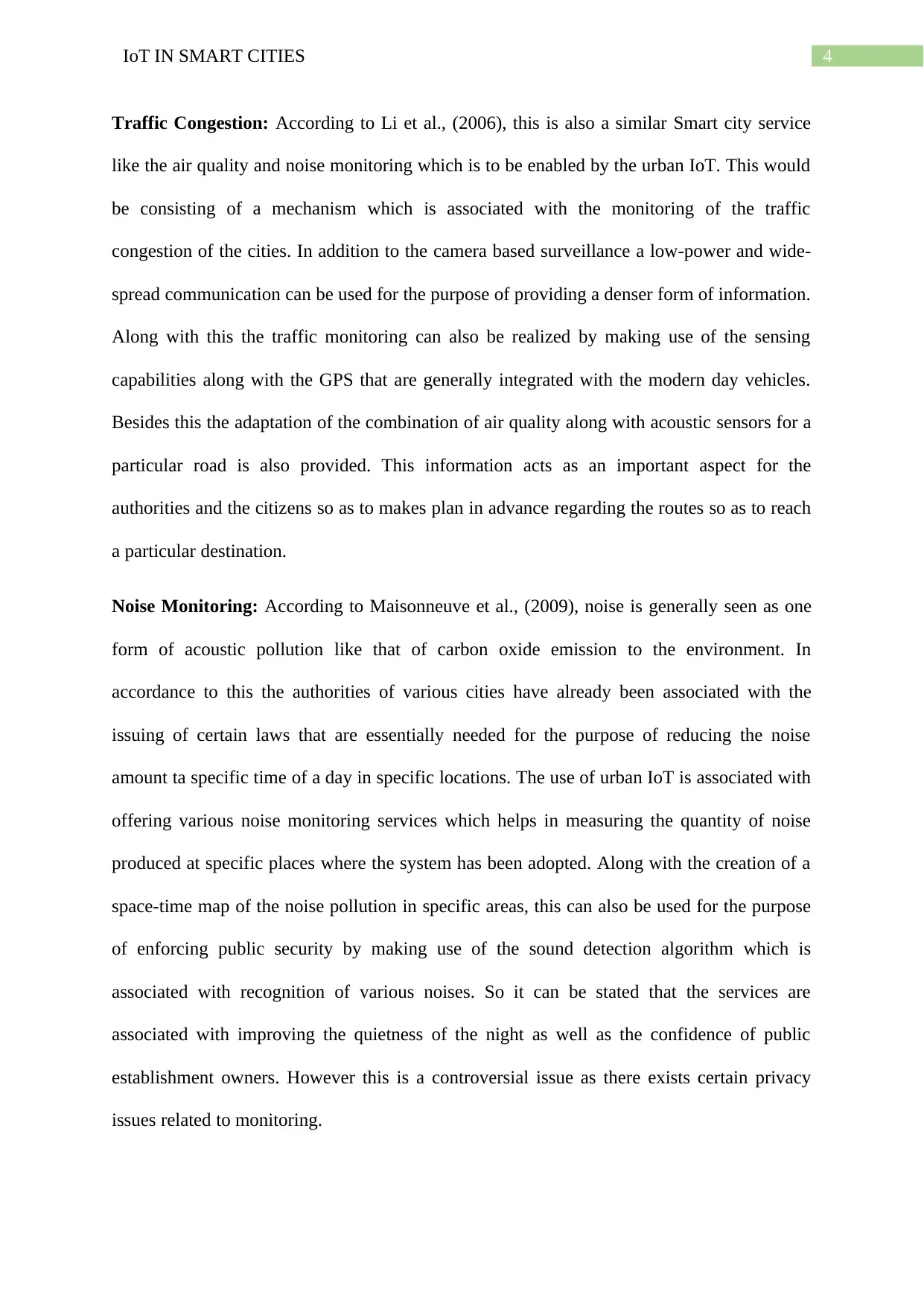
4IoT IN SMART CITIES
Traffic Congestion: According to Li et al., (2006), this is also a similar Smart city service
like the air quality and noise monitoring which is to be enabled by the urban IoT. This would
be consisting of a mechanism which is associated with the monitoring of the traffic
congestion of the cities. In addition to the camera based surveillance a low-power and wide-
spread communication can be used for the purpose of providing a denser form of information.
Along with this the traffic monitoring can also be realized by making use of the sensing
capabilities along with the GPS that are generally integrated with the modern day vehicles.
Besides this the adaptation of the combination of air quality along with acoustic sensors for a
particular road is also provided. This information acts as an important aspect for the
authorities and the citizens so as to makes plan in advance regarding the routes so as to reach
a particular destination.
Noise Monitoring: According to Maisonneuve et al., (2009), noise is generally seen as one
form of acoustic pollution like that of carbon oxide emission to the environment. In
accordance to this the authorities of various cities have already been associated with the
issuing of certain laws that are essentially needed for the purpose of reducing the noise
amount ta specific time of a day in specific locations. The use of urban IoT is associated with
offering various noise monitoring services which helps in measuring the quantity of noise
produced at specific places where the system has been adopted. Along with the creation of a
space-time map of the noise pollution in specific areas, this can also be used for the purpose
of enforcing public security by making use of the sound detection algorithm which is
associated with recognition of various noises. So it can be stated that the services are
associated with improving the quietness of the night as well as the confidence of public
establishment owners. However this is a controversial issue as there exists certain privacy
issues related to monitoring.
Traffic Congestion: According to Li et al., (2006), this is also a similar Smart city service
like the air quality and noise monitoring which is to be enabled by the urban IoT. This would
be consisting of a mechanism which is associated with the monitoring of the traffic
congestion of the cities. In addition to the camera based surveillance a low-power and wide-
spread communication can be used for the purpose of providing a denser form of information.
Along with this the traffic monitoring can also be realized by making use of the sensing
capabilities along with the GPS that are generally integrated with the modern day vehicles.
Besides this the adaptation of the combination of air quality along with acoustic sensors for a
particular road is also provided. This information acts as an important aspect for the
authorities and the citizens so as to makes plan in advance regarding the routes so as to reach
a particular destination.
Noise Monitoring: According to Maisonneuve et al., (2009), noise is generally seen as one
form of acoustic pollution like that of carbon oxide emission to the environment. In
accordance to this the authorities of various cities have already been associated with the
issuing of certain laws that are essentially needed for the purpose of reducing the noise
amount ta specific time of a day in specific locations. The use of urban IoT is associated with
offering various noise monitoring services which helps in measuring the quantity of noise
produced at specific places where the system has been adopted. Along with the creation of a
space-time map of the noise pollution in specific areas, this can also be used for the purpose
of enforcing public security by making use of the sound detection algorithm which is
associated with recognition of various noises. So it can be stated that the services are
associated with improving the quietness of the night as well as the confidence of public
establishment owners. However this is a controversial issue as there exists certain privacy
issues related to monitoring.
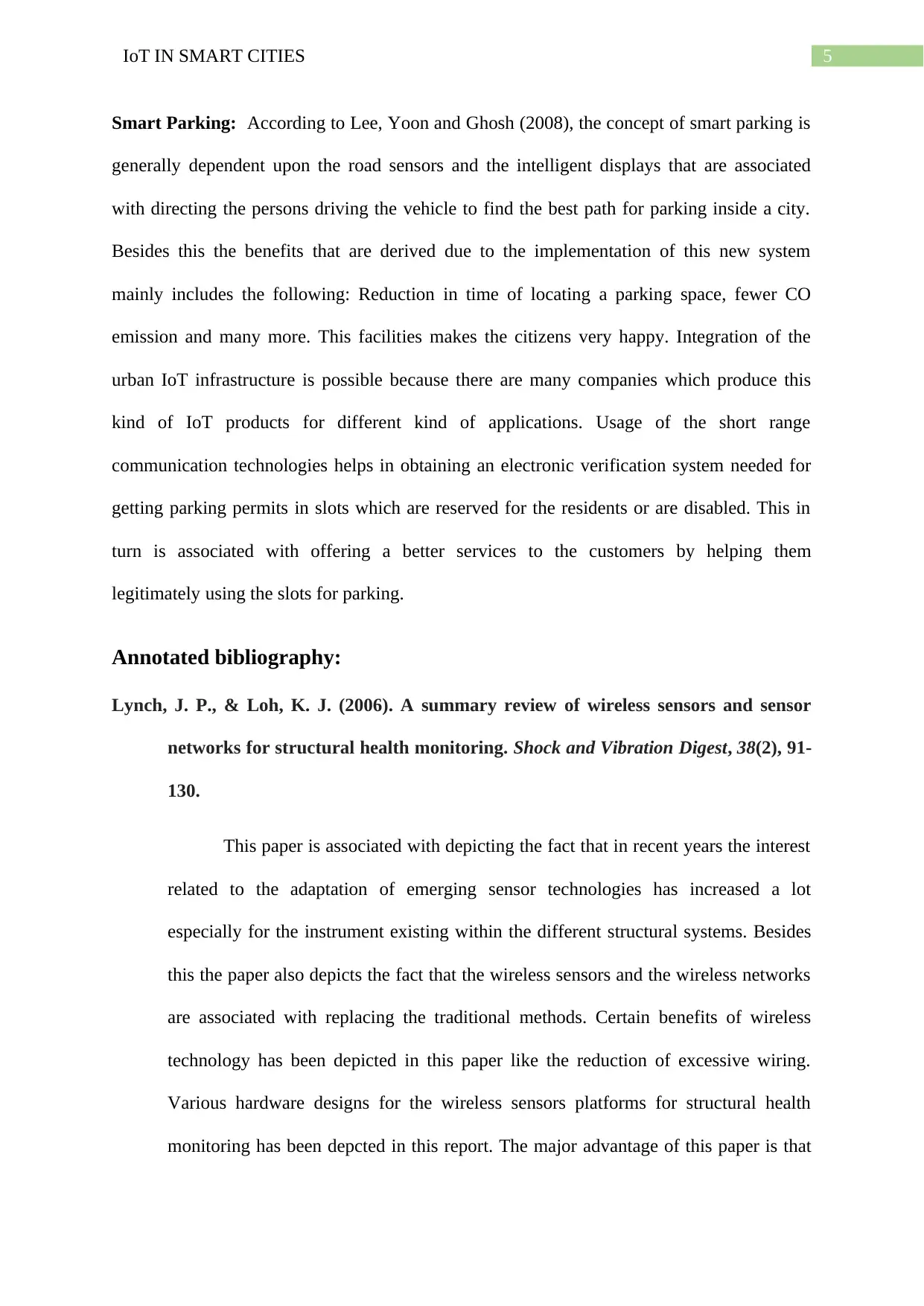
5IoT IN SMART CITIES
Smart Parking: According to Lee, Yoon and Ghosh (2008), the concept of smart parking is
generally dependent upon the road sensors and the intelligent displays that are associated
with directing the persons driving the vehicle to find the best path for parking inside a city.
Besides this the benefits that are derived due to the implementation of this new system
mainly includes the following: Reduction in time of locating a parking space, fewer CO
emission and many more. This facilities makes the citizens very happy. Integration of the
urban IoT infrastructure is possible because there are many companies which produce this
kind of IoT products for different kind of applications. Usage of the short range
communication technologies helps in obtaining an electronic verification system needed for
getting parking permits in slots which are reserved for the residents or are disabled. This in
turn is associated with offering a better services to the customers by helping them
legitimately using the slots for parking.
Annotated bibliography:
Lynch, J. P., & Loh, K. J. (2006). A summary review of wireless sensors and sensor
networks for structural health monitoring. Shock and Vibration Digest, 38(2), 91-
130.
This paper is associated with depicting the fact that in recent years the interest
related to the adaptation of emerging sensor technologies has increased a lot
especially for the instrument existing within the different structural systems. Besides
this the paper also depicts the fact that the wireless sensors and the wireless networks
are associated with replacing the traditional methods. Certain benefits of wireless
technology has been depicted in this paper like the reduction of excessive wiring.
Various hardware designs for the wireless sensors platforms for structural health
monitoring has been depcted in this report. The major advantage of this paper is that
Smart Parking: According to Lee, Yoon and Ghosh (2008), the concept of smart parking is
generally dependent upon the road sensors and the intelligent displays that are associated
with directing the persons driving the vehicle to find the best path for parking inside a city.
Besides this the benefits that are derived due to the implementation of this new system
mainly includes the following: Reduction in time of locating a parking space, fewer CO
emission and many more. This facilities makes the citizens very happy. Integration of the
urban IoT infrastructure is possible because there are many companies which produce this
kind of IoT products for different kind of applications. Usage of the short range
communication technologies helps in obtaining an electronic verification system needed for
getting parking permits in slots which are reserved for the residents or are disabled. This in
turn is associated with offering a better services to the customers by helping them
legitimately using the slots for parking.
Annotated bibliography:
Lynch, J. P., & Loh, K. J. (2006). A summary review of wireless sensors and sensor
networks for structural health monitoring. Shock and Vibration Digest, 38(2), 91-
130.
This paper is associated with depicting the fact that in recent years the interest
related to the adaptation of emerging sensor technologies has increased a lot
especially for the instrument existing within the different structural systems. Besides
this the paper also depicts the fact that the wireless sensors and the wireless networks
are associated with replacing the traditional methods. Certain benefits of wireless
technology has been depicted in this paper like the reduction of excessive wiring.
Various hardware designs for the wireless sensors platforms for structural health
monitoring has been depcted in this report. The major advantage of this paper is that
⊘ This is a preview!⊘
Do you want full access?
Subscribe today to unlock all pages.

Trusted by 1+ million students worldwide
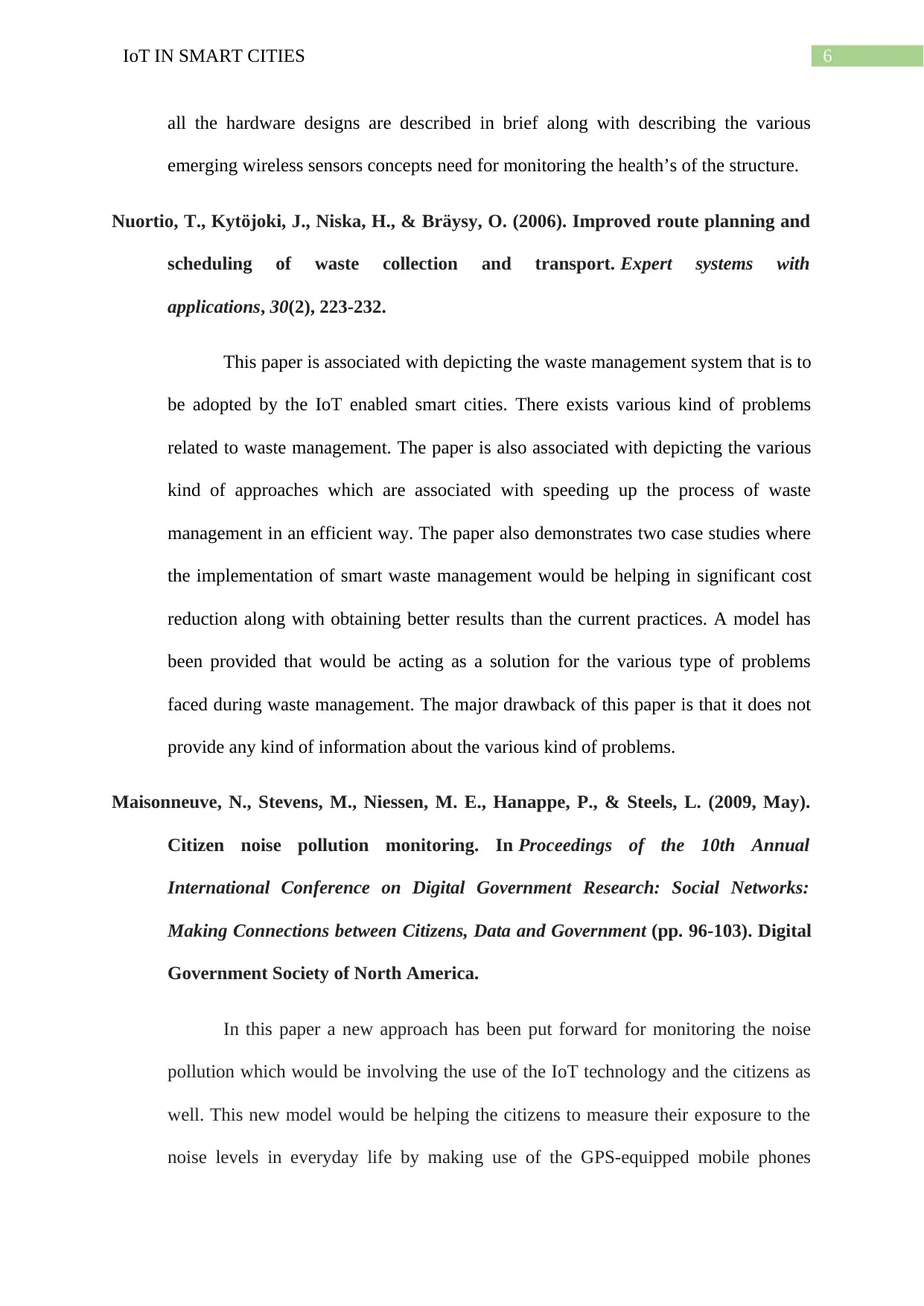
6IoT IN SMART CITIES
all the hardware designs are described in brief along with describing the various
emerging wireless sensors concepts need for monitoring the health’s of the structure.
Nuortio, T., Kytöjoki, J., Niska, H., & Bräysy, O. (2006). Improved route planning and
scheduling of waste collection and transport. Expert systems with
applications, 30(2), 223-232.
This paper is associated with depicting the waste management system that is to
be adopted by the IoT enabled smart cities. There exists various kind of problems
related to waste management. The paper is also associated with depicting the various
kind of approaches which are associated with speeding up the process of waste
management in an efficient way. The paper also demonstrates two case studies where
the implementation of smart waste management would be helping in significant cost
reduction along with obtaining better results than the current practices. A model has
been provided that would be acting as a solution for the various type of problems
faced during waste management. The major drawback of this paper is that it does not
provide any kind of information about the various kind of problems.
Maisonneuve, N., Stevens, M., Niessen, M. E., Hanappe, P., & Steels, L. (2009, May).
Citizen noise pollution monitoring. In Proceedings of the 10th Annual
International Conference on Digital Government Research: Social Networks:
Making Connections between Citizens, Data and Government (pp. 96-103). Digital
Government Society of North America.
In this paper a new approach has been put forward for monitoring the noise
pollution which would be involving the use of the IoT technology and the citizens as
well. This new model would be helping the citizens to measure their exposure to the
noise levels in everyday life by making use of the GPS-equipped mobile phones
all the hardware designs are described in brief along with describing the various
emerging wireless sensors concepts need for monitoring the health’s of the structure.
Nuortio, T., Kytöjoki, J., Niska, H., & Bräysy, O. (2006). Improved route planning and
scheduling of waste collection and transport. Expert systems with
applications, 30(2), 223-232.
This paper is associated with depicting the waste management system that is to
be adopted by the IoT enabled smart cities. There exists various kind of problems
related to waste management. The paper is also associated with depicting the various
kind of approaches which are associated with speeding up the process of waste
management in an efficient way. The paper also demonstrates two case studies where
the implementation of smart waste management would be helping in significant cost
reduction along with obtaining better results than the current practices. A model has
been provided that would be acting as a solution for the various type of problems
faced during waste management. The major drawback of this paper is that it does not
provide any kind of information about the various kind of problems.
Maisonneuve, N., Stevens, M., Niessen, M. E., Hanappe, P., & Steels, L. (2009, May).
Citizen noise pollution monitoring. In Proceedings of the 10th Annual
International Conference on Digital Government Research: Social Networks:
Making Connections between Citizens, Data and Government (pp. 96-103). Digital
Government Society of North America.
In this paper a new approach has been put forward for monitoring the noise
pollution which would be involving the use of the IoT technology and the citizens as
well. This new model would be helping the citizens to measure their exposure to the
noise levels in everyday life by making use of the GPS-equipped mobile phones
Paraphrase This Document
Need a fresh take? Get an instant paraphrase of this document with our AI Paraphraser
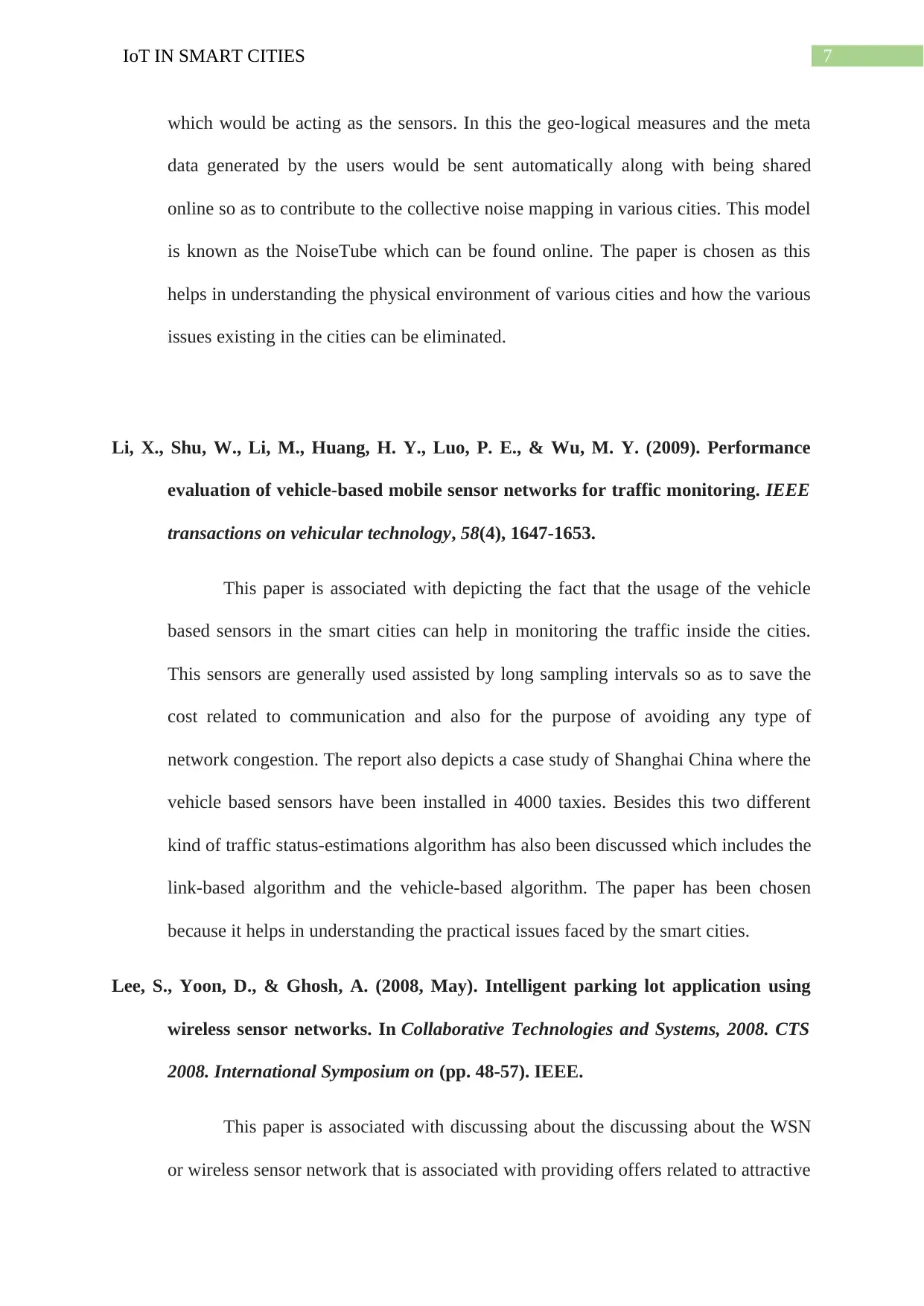
7IoT IN SMART CITIES
which would be acting as the sensors. In this the geo-logical measures and the meta
data generated by the users would be sent automatically along with being shared
online so as to contribute to the collective noise mapping in various cities. This model
is known as the NoiseTube which can be found online. The paper is chosen as this
helps in understanding the physical environment of various cities and how the various
issues existing in the cities can be eliminated.
Li, X., Shu, W., Li, M., Huang, H. Y., Luo, P. E., & Wu, M. Y. (2009). Performance
evaluation of vehicle-based mobile sensor networks for traffic monitoring. IEEE
transactions on vehicular technology, 58(4), 1647-1653.
This paper is associated with depicting the fact that the usage of the vehicle
based sensors in the smart cities can help in monitoring the traffic inside the cities.
This sensors are generally used assisted by long sampling intervals so as to save the
cost related to communication and also for the purpose of avoiding any type of
network congestion. The report also depicts a case study of Shanghai China where the
vehicle based sensors have been installed in 4000 taxies. Besides this two different
kind of traffic status-estimations algorithm has also been discussed which includes the
link-based algorithm and the vehicle-based algorithm. The paper has been chosen
because it helps in understanding the practical issues faced by the smart cities.
Lee, S., Yoon, D., & Ghosh, A. (2008, May). Intelligent parking lot application using
wireless sensor networks. In Collaborative Technologies and Systems, 2008. CTS
2008. International Symposium on (pp. 48-57). IEEE.
This paper is associated with discussing about the discussing about the WSN
or wireless sensor network that is associated with providing offers related to attractive
which would be acting as the sensors. In this the geo-logical measures and the meta
data generated by the users would be sent automatically along with being shared
online so as to contribute to the collective noise mapping in various cities. This model
is known as the NoiseTube which can be found online. The paper is chosen as this
helps in understanding the physical environment of various cities and how the various
issues existing in the cities can be eliminated.
Li, X., Shu, W., Li, M., Huang, H. Y., Luo, P. E., & Wu, M. Y. (2009). Performance
evaluation of vehicle-based mobile sensor networks for traffic monitoring. IEEE
transactions on vehicular technology, 58(4), 1647-1653.
This paper is associated with depicting the fact that the usage of the vehicle
based sensors in the smart cities can help in monitoring the traffic inside the cities.
This sensors are generally used assisted by long sampling intervals so as to save the
cost related to communication and also for the purpose of avoiding any type of
network congestion. The report also depicts a case study of Shanghai China where the
vehicle based sensors have been installed in 4000 taxies. Besides this two different
kind of traffic status-estimations algorithm has also been discussed which includes the
link-based algorithm and the vehicle-based algorithm. The paper has been chosen
because it helps in understanding the practical issues faced by the smart cities.
Lee, S., Yoon, D., & Ghosh, A. (2008, May). Intelligent parking lot application using
wireless sensor networks. In Collaborative Technologies and Systems, 2008. CTS
2008. International Symposium on (pp. 48-57). IEEE.
This paper is associated with discussing about the discussing about the WSN
or wireless sensor network that is associated with providing offers related to attractive
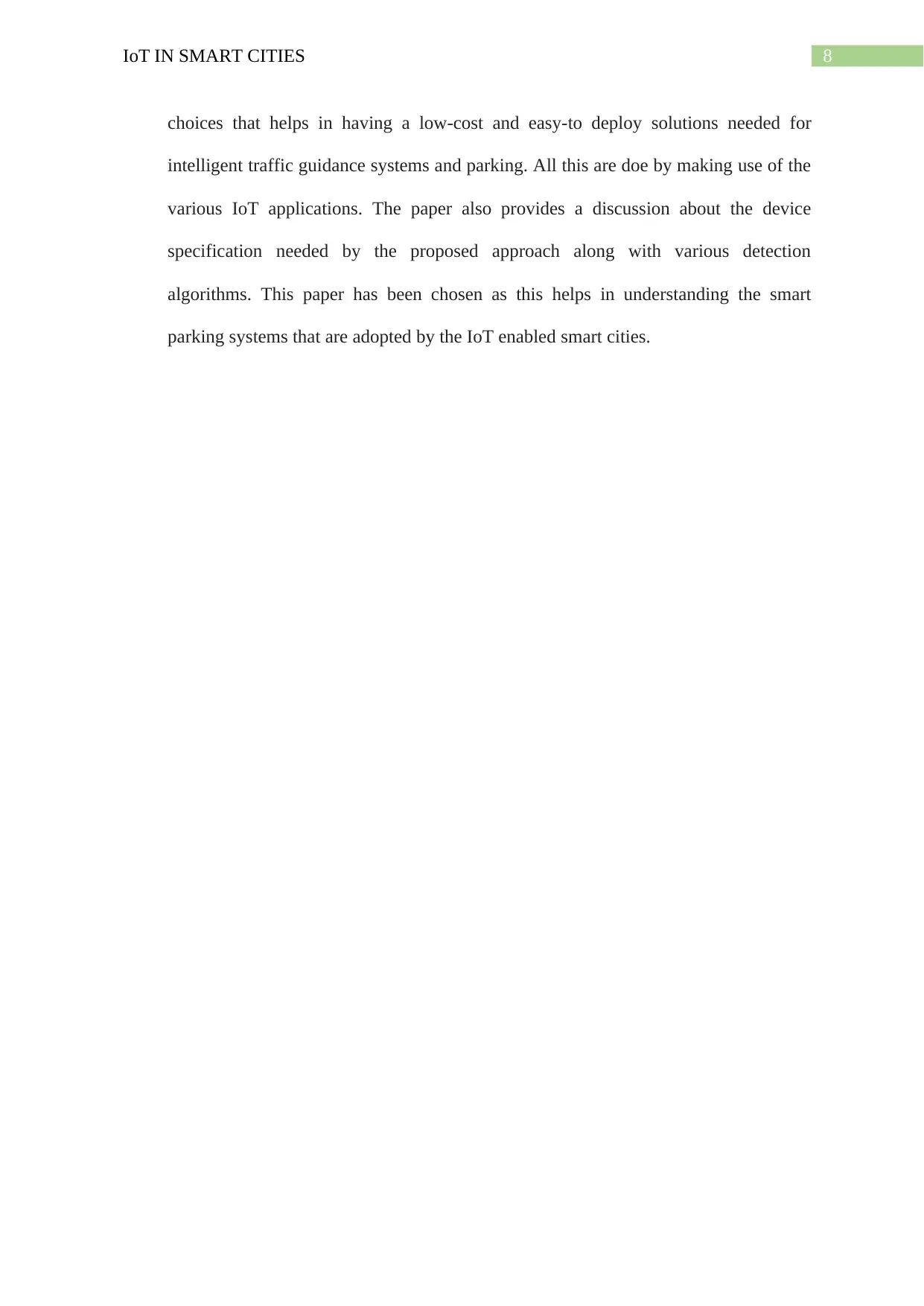
8IoT IN SMART CITIES
choices that helps in having a low-cost and easy-to deploy solutions needed for
intelligent traffic guidance systems and parking. All this are doe by making use of the
various IoT applications. The paper also provides a discussion about the device
specification needed by the proposed approach along with various detection
algorithms. This paper has been chosen as this helps in understanding the smart
parking systems that are adopted by the IoT enabled smart cities.
choices that helps in having a low-cost and easy-to deploy solutions needed for
intelligent traffic guidance systems and parking. All this are doe by making use of the
various IoT applications. The paper also provides a discussion about the device
specification needed by the proposed approach along with various detection
algorithms. This paper has been chosen as this helps in understanding the smart
parking systems that are adopted by the IoT enabled smart cities.
⊘ This is a preview!⊘
Do you want full access?
Subscribe today to unlock all pages.

Trusted by 1+ million students worldwide
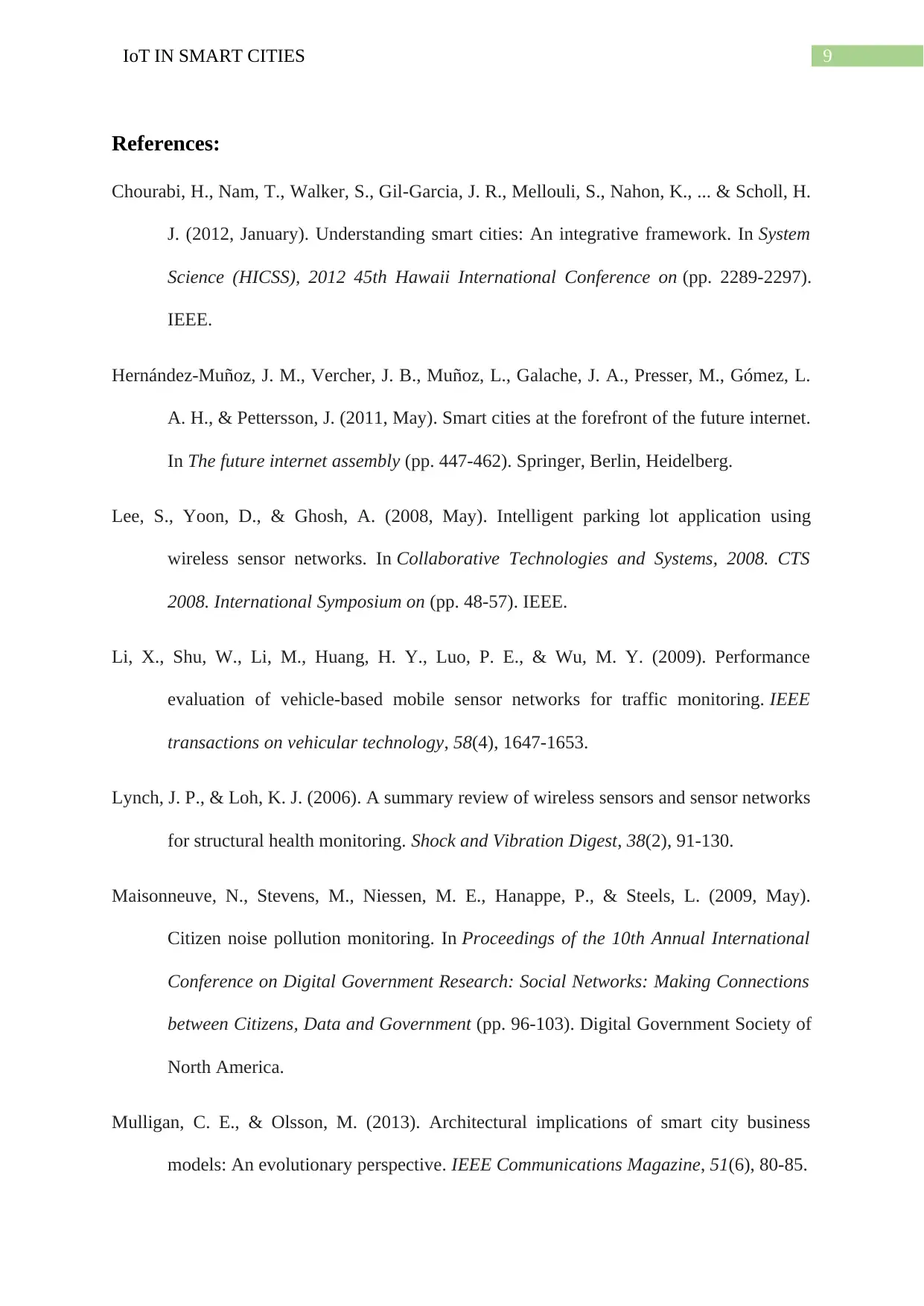
9IoT IN SMART CITIES
References:
Chourabi, H., Nam, T., Walker, S., Gil-Garcia, J. R., Mellouli, S., Nahon, K., ... & Scholl, H.
J. (2012, January). Understanding smart cities: An integrative framework. In System
Science (HICSS), 2012 45th Hawaii International Conference on (pp. 2289-2297).
IEEE.
Hernández-Muñoz, J. M., Vercher, J. B., Muñoz, L., Galache, J. A., Presser, M., Gómez, L.
A. H., & Pettersson, J. (2011, May). Smart cities at the forefront of the future internet.
In The future internet assembly (pp. 447-462). Springer, Berlin, Heidelberg.
Lee, S., Yoon, D., & Ghosh, A. (2008, May). Intelligent parking lot application using
wireless sensor networks. In Collaborative Technologies and Systems, 2008. CTS
2008. International Symposium on (pp. 48-57). IEEE.
Li, X., Shu, W., Li, M., Huang, H. Y., Luo, P. E., & Wu, M. Y. (2009). Performance
evaluation of vehicle-based mobile sensor networks for traffic monitoring. IEEE
transactions on vehicular technology, 58(4), 1647-1653.
Lynch, J. P., & Loh, K. J. (2006). A summary review of wireless sensors and sensor networks
for structural health monitoring. Shock and Vibration Digest, 38(2), 91-130.
Maisonneuve, N., Stevens, M., Niessen, M. E., Hanappe, P., & Steels, L. (2009, May).
Citizen noise pollution monitoring. In Proceedings of the 10th Annual International
Conference on Digital Government Research: Social Networks: Making Connections
between Citizens, Data and Government (pp. 96-103). Digital Government Society of
North America.
Mulligan, C. E., & Olsson, M. (2013). Architectural implications of smart city business
models: An evolutionary perspective. IEEE Communications Magazine, 51(6), 80-85.
References:
Chourabi, H., Nam, T., Walker, S., Gil-Garcia, J. R., Mellouli, S., Nahon, K., ... & Scholl, H.
J. (2012, January). Understanding smart cities: An integrative framework. In System
Science (HICSS), 2012 45th Hawaii International Conference on (pp. 2289-2297).
IEEE.
Hernández-Muñoz, J. M., Vercher, J. B., Muñoz, L., Galache, J. A., Presser, M., Gómez, L.
A. H., & Pettersson, J. (2011, May). Smart cities at the forefront of the future internet.
In The future internet assembly (pp. 447-462). Springer, Berlin, Heidelberg.
Lee, S., Yoon, D., & Ghosh, A. (2008, May). Intelligent parking lot application using
wireless sensor networks. In Collaborative Technologies and Systems, 2008. CTS
2008. International Symposium on (pp. 48-57). IEEE.
Li, X., Shu, W., Li, M., Huang, H. Y., Luo, P. E., & Wu, M. Y. (2009). Performance
evaluation of vehicle-based mobile sensor networks for traffic monitoring. IEEE
transactions on vehicular technology, 58(4), 1647-1653.
Lynch, J. P., & Loh, K. J. (2006). A summary review of wireless sensors and sensor networks
for structural health monitoring. Shock and Vibration Digest, 38(2), 91-130.
Maisonneuve, N., Stevens, M., Niessen, M. E., Hanappe, P., & Steels, L. (2009, May).
Citizen noise pollution monitoring. In Proceedings of the 10th Annual International
Conference on Digital Government Research: Social Networks: Making Connections
between Citizens, Data and Government (pp. 96-103). Digital Government Society of
North America.
Mulligan, C. E., & Olsson, M. (2013). Architectural implications of smart city business
models: An evolutionary perspective. IEEE Communications Magazine, 51(6), 80-85.
Paraphrase This Document
Need a fresh take? Get an instant paraphrase of this document with our AI Paraphraser
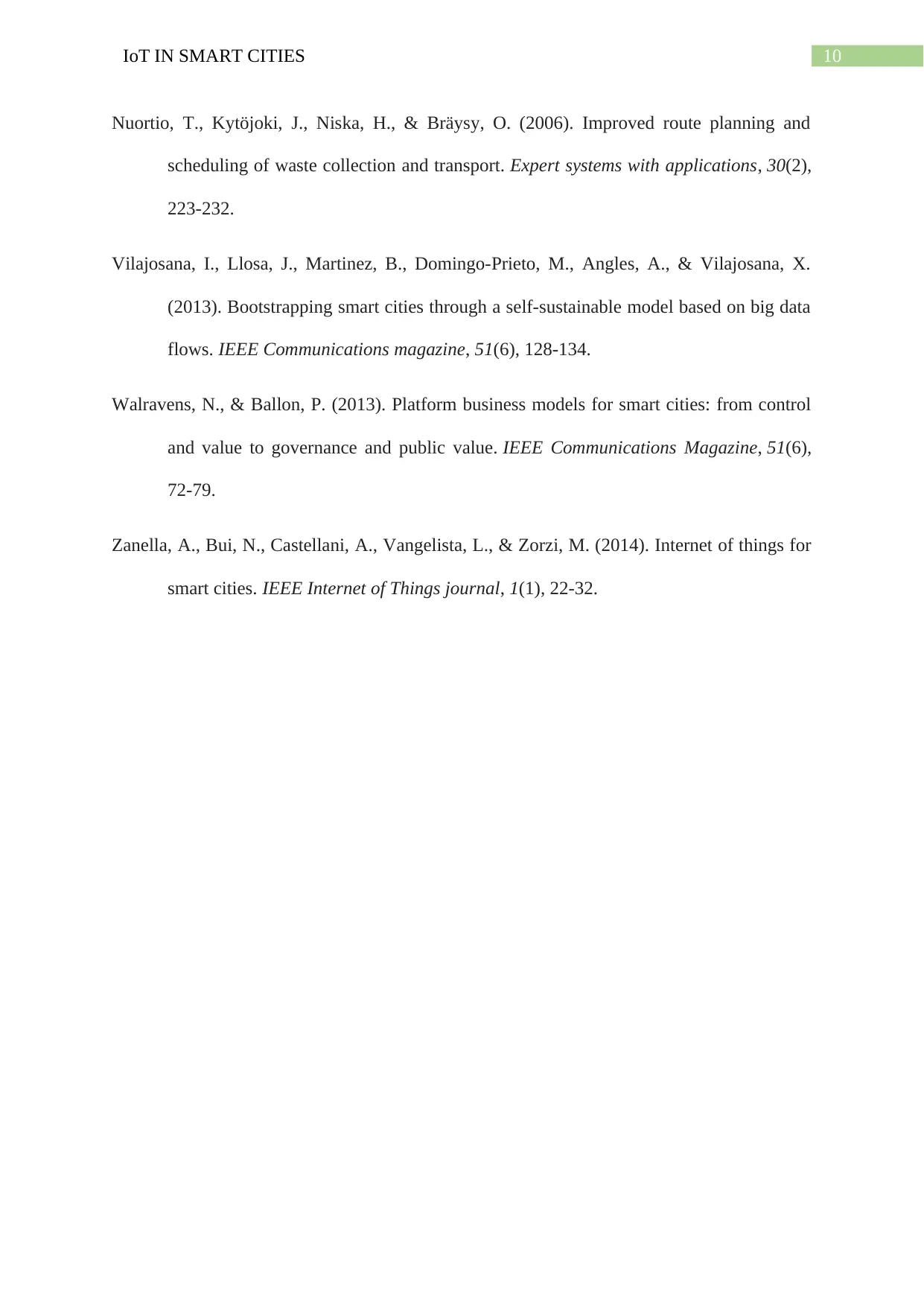
10IoT IN SMART CITIES
Nuortio, T., Kytöjoki, J., Niska, H., & Bräysy, O. (2006). Improved route planning and
scheduling of waste collection and transport. Expert systems with applications, 30(2),
223-232.
Vilajosana, I., Llosa, J., Martinez, B., Domingo-Prieto, M., Angles, A., & Vilajosana, X.
(2013). Bootstrapping smart cities through a self-sustainable model based on big data
flows. IEEE Communications magazine, 51(6), 128-134.
Walravens, N., & Ballon, P. (2013). Platform business models for smart cities: from control
and value to governance and public value. IEEE Communications Magazine, 51(6),
72-79.
Zanella, A., Bui, N., Castellani, A., Vangelista, L., & Zorzi, M. (2014). Internet of things for
smart cities. IEEE Internet of Things journal, 1(1), 22-32.
Nuortio, T., Kytöjoki, J., Niska, H., & Bräysy, O. (2006). Improved route planning and
scheduling of waste collection and transport. Expert systems with applications, 30(2),
223-232.
Vilajosana, I., Llosa, J., Martinez, B., Domingo-Prieto, M., Angles, A., & Vilajosana, X.
(2013). Bootstrapping smart cities through a self-sustainable model based on big data
flows. IEEE Communications magazine, 51(6), 128-134.
Walravens, N., & Ballon, P. (2013). Platform business models for smart cities: from control
and value to governance and public value. IEEE Communications Magazine, 51(6),
72-79.
Zanella, A., Bui, N., Castellani, A., Vangelista, L., & Zorzi, M. (2014). Internet of things for
smart cities. IEEE Internet of Things journal, 1(1), 22-32.
1 out of 11
Related Documents
Your All-in-One AI-Powered Toolkit for Academic Success.
+13062052269
info@desklib.com
Available 24*7 on WhatsApp / Email
![[object Object]](/_next/static/media/star-bottom.7253800d.svg)
Unlock your academic potential
Copyright © 2020–2025 A2Z Services. All Rights Reserved. Developed and managed by ZUCOL.





